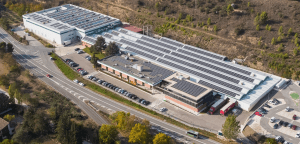I’ve been reading and receiving a bunch of information on DCIM (Data Center Infrastructure Management) software for the last few years. I’m not sure if other people have this same impression but my conclusion is that no one really knows what it is. The category suffers from a lack of a solid and accepted definition.
I’ve seen some companies who are effectively ‘one trick ponies’ selling basic software to monitor simple temperature sensors who are positioning themselves as a ‘DCIM vendor’. Generating some colorful heat maps based on sensor data (how accurate are those anyway?) is not in my opinion anything close to what I consider DCIM. In my mind, this claim is similar to a tire manufacturer saying they are a car vendor.
While this example may be extreme, this confusion has existed for the last 3-4 years at a minimum. The DCIM term really emerged when data center operators started looking for a better tool to help them track the assets and plan for changes in their data center, but it’s since then many software vendors have taken liberties by using the DCIM term to mean “any software that I can sell to a Data Center” and this is the root of all the current ambiguity
Typically, most data centers I’ve seen use some kind of tool, usually a spreadsheet, to manually track their assets. The limitation most managers seem to have is that the spreadsheet isn’t always current and accurate so they have difficulty tracking dependencies with complex infrastructure elements such as electrical connections. In other words, the server is located in Rack ‘xyz’, connected to PDU ‘abc’ and PDU ‘def’. Now imagine using that spreadsheet to start understanding and modeling cooling dependencies and you can start to understand the limits of the tool.
We entered the market a number of years ago with a software tool to address this need. At the time, we were the only vendor that was merging together the asset information with real time* data from a monitoring system that focused on the interrelationship between power and cooling data within the IT Room or ‘white space’. Lack of this real time information was quickly recognized by our competitors in the market as a weakness in their offer and they either developed their own or were acquired by a bigger company who needed the asset and inventory capability.
When I talk to industry analyst and customers it’s clear that there isn’t a clear consensus on whether this DCIM term includes the monitoring portion of the IT Room or just the asset/inventory information.
Regardless of the inclusion of IT Room monitoring in the definition, one of the other big limitations of this definition from my view is it ignores the larger facility infrastructure. It’s not unusual for Data Center Managers to view the data center as the IT Space itself and forget that there are electrical components like switchgear, and cooling equipment like chillers and all sorts of other fun stuff that are just as critical to maintain uptime. I also believe that in the future you will see the need for looking across these traditional boundaries become more critical than it has historically been (… but that is a topic for another day).
My view is that true “Data Center Management” will have to incorporate an understanding of the facility and its impact on the IT Room physical infrastructure and ultimately the impact on IT equipment itself. With our announcement of StruxureWare for Data Centers, we coined a term DCFM (Data Center Facility Management) to help highlight this need. Simply defined, DCFM is intended to incorporate all the monitoring systems capturing power and cooling data from the facility to rack.
DCIM in contrast is defined in this context to mean the tools necessary to manage the day to day operations such as moves, adds, and changes. Planning tools that help simulate and predict the impact of future deployments are also under this definition.
Perhaps someday DCIM will be used to truly mean the entire infrastructure. But right now some people seem to live in a dream world where the power and cooling magically appears from a wire or pipe that comes through the wall. In other words, they forget about the facility. And without the facility, you don’t have a data center. So we think DCFM is something that needs to be discussed.
Check out our White Paper #104 where I try to explain this model in more detail.
* Real time – My use of the term real-time is meant within a second or two. I’m sure a SCADA industrial process person would find that definition to not truly be ‘real time’. An interesting discussion but I don’t believe is critical to my comments here.
Please follow me on Twitter!
About Kevin Brown:
Kevin Brown is Vice President, Data Center Global Offer for Schneider Electric. He leads of team of industry professionals to develop and bring to market solutions for the data center market. In this role, he has responsibility to articulate the vision for Schneider Electric’s data center offer and create comprehensive data center solutions that solve real customer problems today. Kevin is an experienced industry professional in both the IT and HVAC industry. He has over 20 years experience at Schneider Electric in a variety of senior management roles including product development, product management, marketing, and sales.



Conversation
DCIM, Can contain a variety of items mentioned in your post, the true DCIM model, can be built, IF you have the:
Commitment from the client on budget dollars to justify the need.
The Realtime data collection infrastructure built into the system from the beginning.
The on-site Property Management or Owners that have the knowledge and the ability to teach others how to manage, operate and update the littlest things like the calibration, offset values, time intervals in PM program.
Communication policy to the client, who will take ownership of said systems? The client, the engineer or both?
The need to have dedicated staff, that have a vested interest in maintaining this data, other than, just a job. A sense of ownership with no hidden agendas or be smart enough to realize, that sharing such information, mentoring others to do the same in your absence, is an integral part of the success. Garbage in = Garbage out, so, an effort and commitment of ownership, consistent procedures shared with the ones operating the equipment in addition to the Realtime data, being pushed over a global network, client access for viewing and error recording and reporting. Wouldn’t it be nice to hit a share point as a client, just after you heard that there was an issue in FL, or TX, the ability to look at the dashboard, and pull up that Realtime data, including high level overview, simple as all good/not good or a detailed analysis of the wave form captures, sags, surges, frequency deviations on the input and the output of the UPM modules. There it so much information for any one person to handle, a team effort. Not only on the client and PM company side, but from vendors like yourself, working with peers in your industry, to ensure that the client is getting a reliable system and that the vendors are not competing for all the goods, that you are equally sharing in the best interest of the client. IMO
Paul,
You bring up some excellent points that I emphasize when I meet with customers.
1) Software tools are only as good as the business process and procedures behind using them.
2) Software tools should all be using and embracing open standards to get information out of them. I’ve seen many examples of sharepoint used by data center managers as you state. These are the mythical ‘dashboard’ in my view – specialized summary interface specific to the particular user. The only way this view can happen is with rich accurate data that is openly available.
Thanks for the comment!
Kevin
Kevin,
I agree with every word of our article.
I think the scenario you talk about reflects the true dis-connect that still exists between IT and FM.
This i starting to change but will take time.
I am of the opinion that the divide will be driven (in the UK) by CRC compliance and the ever ncreasing cost of energy.
A good article.
Kind regards
Paul Aguilar
Unite Technologies
It’s interesting that you bring up the disconnect between IT and FM.
I see come companies starting to merge the organizations. Even when they are merged it still takes time – software alone won’t solve the problem.
I once heard a famous economist say “Sociology beats economics every time”. I think that’s true here as well.
Thanks for the comment!
Kevin
Kevin,
You are, of-course, entitled to your opinions. It just so happens that I agree 100%… 😉
I feel the need for another acronym as much as a hole in the head, but that is possibly what is needed here; your DCFM for Facilities Management, or Gartner new one DCEM for Energy Management may fracture the DCIM space and make it possible for the solutions suppliers to find the proper fit.
Right now it is a “free for all” and if it is hard for us in the domain to evaluate all these claims, imagine what it does for the customers.
To me, DCIM should include even such trivial tasks as to keep track on how long fuel has been sitting in the generators reservoirs (bacterial growth problems).
So, is a software to keep track of maintenance contracts part of DCIM? Sure. Asset tracking software? Absolutely. Environmental monitoring? Of-course.
They present themselves as “complete DCIM solutions” ? Don’t make me laugh.
BTW, you sounded a bit “defensive” on your definition of real-time data against SCADA’s. Don’t be. Sub-second detection is normally used to trigger an automated action (pretty common in industrial systems). How often have you seen automated actions following an alarm in a data center? (Besides fire alarms, of-course)
A pertinent article, thank you.
Great feedback – usually I enjoy free for alls!
Me? Defensive? I’m not being defensive….do I sound defensive? Did someone tell you I was being defensive?
(tongue firmly in cheek BTW – the marketing people didn’t believe you’d get the sarcasm….)
Thank you for the comment – you bring up some excellent points. I love the generator idea, I hadn’t thought of that one.
Kevin